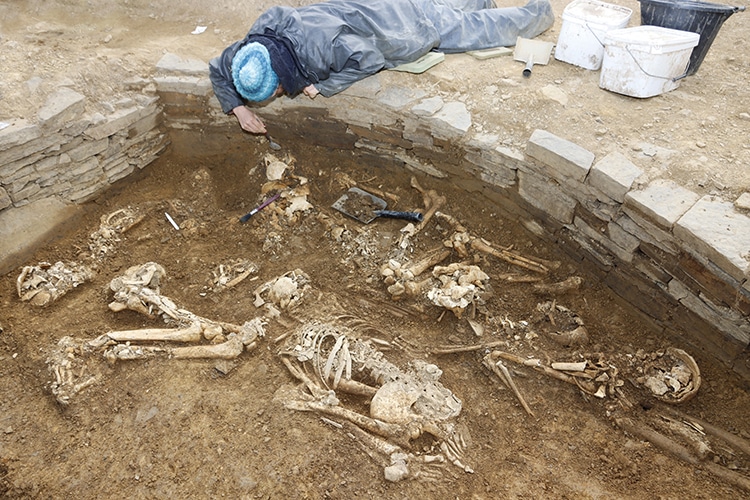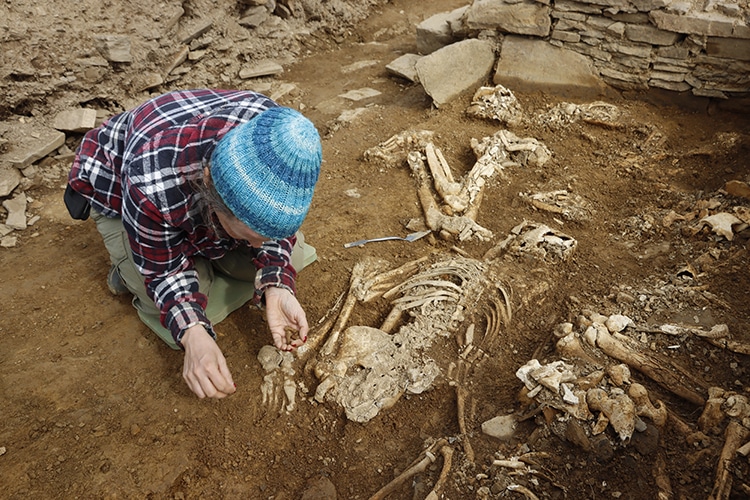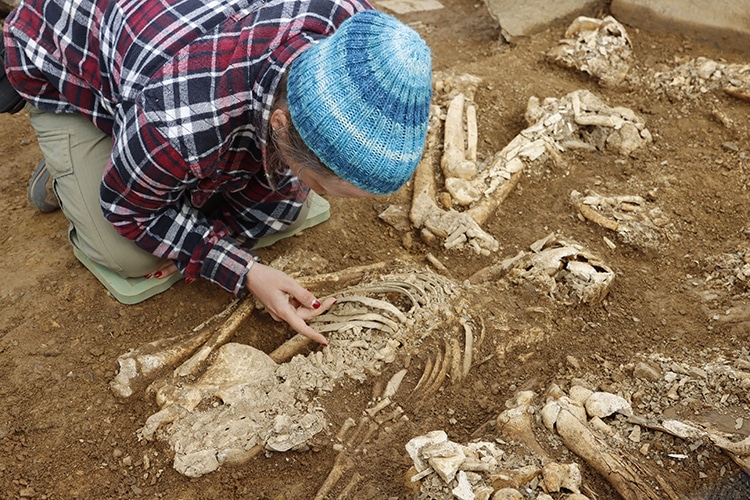
Photo: National Museums Scotland
Magnificent ancient tombs are not limited to the pyramids of Egypt or the ceramic-filled vaults of China. In far northern Scotland, Neolithic monuments abound across Orkney. Among these prehistoric sites are imposing mounds which hide stone brave complexes known as chambered cairns. While typically the mound of Earth heaped on top of the complex rises like a small hill, visible to passersby, these terrestrial indications were lost for one particular gravesite. When the earth and stones were moved in the 19th century by a local farmer, the graves below fell into obscurity. With much detective work, archeologists have now uncovered the impressively engineered tomb complex, including its strange pair of hugging skeletons.
Orkney is a series of islands off the northeastern tip of Scotland. It has rich prehistoric archeology, including Stonehenge-like monuments: the Stones of Stenness and the Ring of Brodgar. Its most famous tomb is a chambered one known as Maes Howe. Similar tombs from the Neolithic period, built about 5,000 years ago, are known as Maes-Howe-type. The recently re-uncovered tomb is of this kind. Originally discovered in the 19th century, it was mentioned in contemporary newspapers. However, the leveling of the raised portion sent it back to obscurity.
Hugo Anderson-Whymark, of the National Museums Scotland, began a quest for the tomb in 2020. Using the clippings and an old sketch pointing towards the location, he found the site in summer 2023. Underground were stone walls creating a passageway leading into a 49-foot diameter circular structure. A central chamber and six smaller ones within had corbeled stone roofs. One of the side chambers held 14 skeletons of men, women, and children. Search of the material moved in the 19th century yielded pottery, stone tools, and a bone pin.
Vicki Cummings of Cardiff University, who co-led the excavation, said in a statement: “The preservation of so many human remains in one part of the monument is amazing, especially since the stone has been mostly robbed for building material. It is incredibly rare to find these tomb deposits, even in well-preserved chambered tombs and these remains will enable new insights into all aspects of these peoples’ lives.” Two sets of remains are uniquely postured, as if hugging even in death. “They could’ve been buried at the same time in crouched positions like they were embracing,” Anderson-Whymark told Live Science. “It looked like they were deliberately put in close relation to each other. We also found another skeleton whose arm was outstretched toward a different skeleton.”
The impressive stone engineering of the tomb adds to the uniqueness of the find. Only 12 Maes Howe-type passage graves are known in Orkney. “The tomb would’ve been impressive to see when it was fully standing,” Anderson-Whymark notes. “It came within inches of being destroyed in the 19th century.” There are still questions to be answered. DNA testing will illuminate whether the hugging skeletons are related, and further excavation might shed more light on Neolithic life. Meanwhile, visitors to this beautiful, remote corner of the world will be able to visit similar prehistoric sites and immerse themselves in impressive local history.
Archeologists have uncovered a tomb filled with 14 human skeletons.

Photo: National Museums Scotland
Two of them appear to be hugging.

Photo: National Museums Scotland
“These remains will enable new insights into all aspects of these peoples’ lives.”

Photo: National Museums Scotland
h/t: [Live Science]
Related Articles:
Perfectly Preserved 3,000-Year-Old Bronze Sword Discovered in Germany
Oldest Neanderthal Engravings Have Been Preserved in a Cave for 57,000 Years
Archeologists Discover ”Pizza” in an Ancient Pompeii Mural
Archeologists Excavate 4,000-Year-Old “Dutch Stonehenge” in the Netherlands
